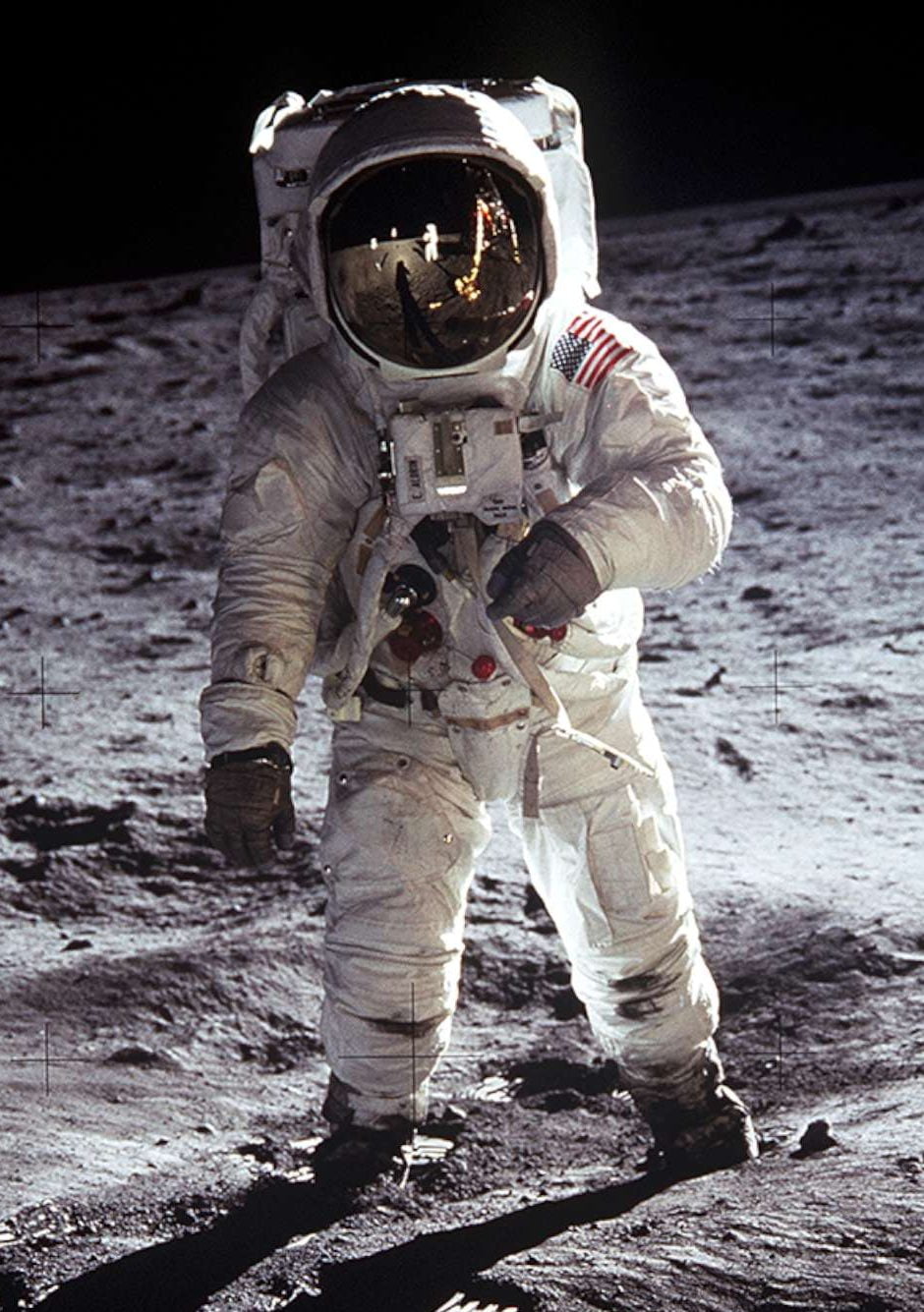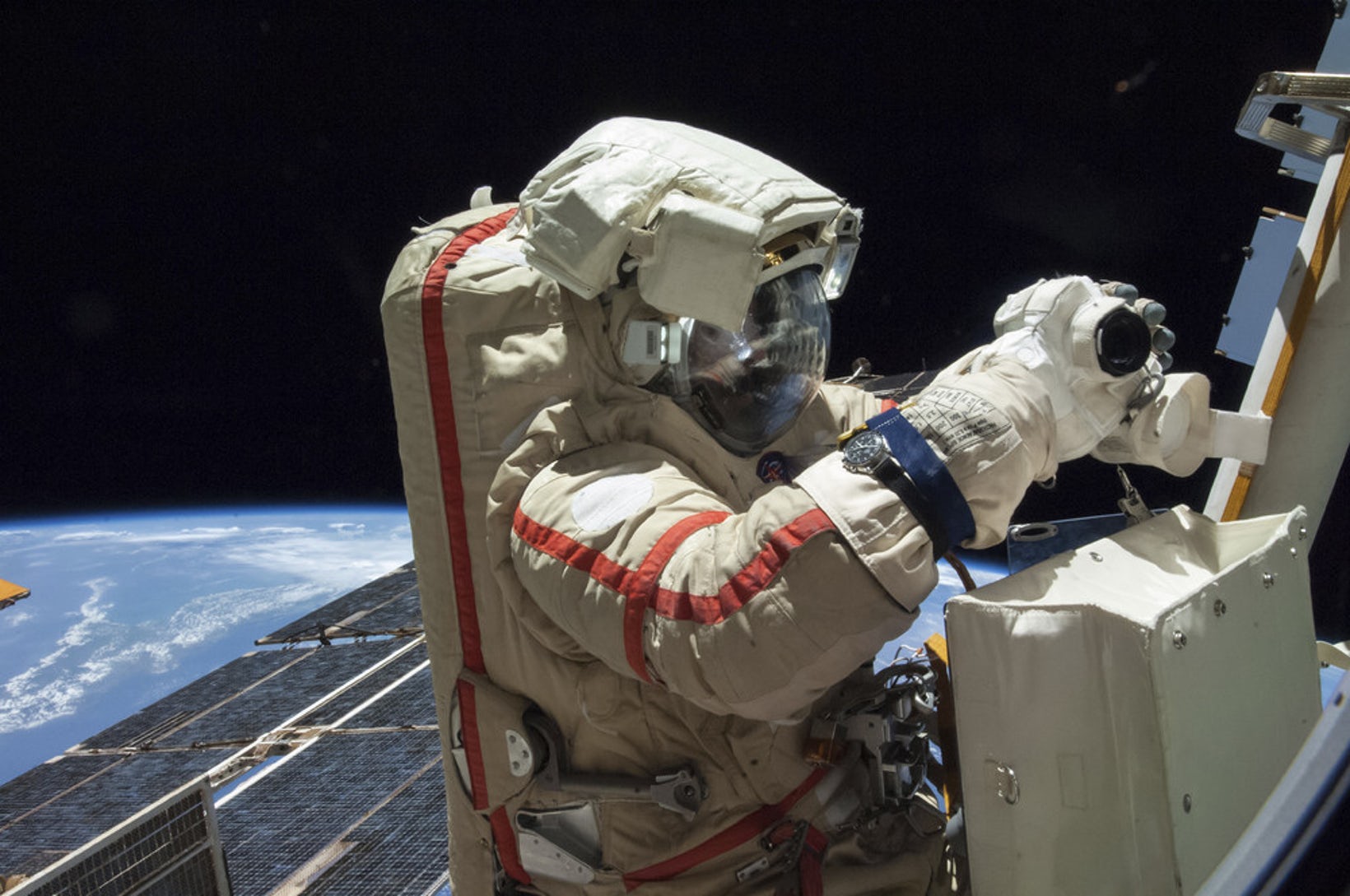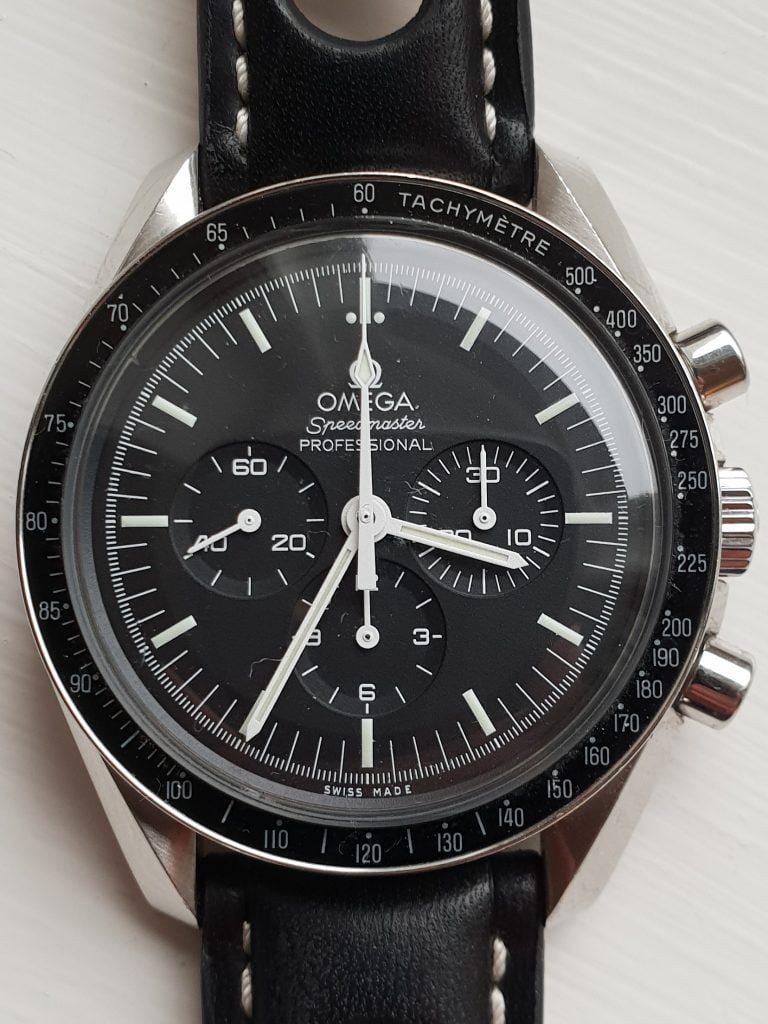| Brand | Omega |
| Model | Speedmaster Professional |
| Year | 2015 |
| Caliber | Cal. 1861 |
| Details | Size 42/14/20 (w/h/lug mm) Org BIG box and papers |
| Links | Omega Moonwatch Omega Speedmaster History Ten things you didn’t know about the Omega Speedmaster |
| Search | dba.dk / “Omega” chrono24 / “Omega” |
>>
The Speedmaster was named for its tachymeter. The Omega Speedmaster was introduced in 1957, only a few years before its selection by NASA, and at that time, the tachymeter scale on the bezel, which enabled speed to be read off by timing a fixed distance, was something new, and so Omega simply created a variant on their existing brands Seamaster and Railmaster.
The Moonwatch
Omega was chosen by NASA after a gruelling series of tests. The Omega Speedmaster is the only watch approved by NASA for manned space flights. In the early 1960s, the Omega had already been in space, worn by Wally Schirra on his Mercury flight in October 1962, and NASA were considering a watch for use in the upcoming missions. Two NASA officials bought a series of chronograph watches anonymously in a few Houston jewellery stores and started testing them.
The watches underwent a series of processes called the “Qualification Test Procedures” which included 11 different tests
- High temperature test: 70° C for 48 hours, then 93° C for 30 minutes in a partial vacuum.
- Low temperature test: -18° C for 4 hours.
- Vacuum test: heated in a vacuum chamber and then cooled to -18° C for several cycles.
- Humidity test: ten 24-hour cycles in >95% humidity with temperatures ranging from 25° C to 70° C.
- Corrosion test: in an atmosphere of oxygen at 70° C for 48 hours.
- Shock-resistance test: six 40 G shocks in six different directions.
- Acceleration test: progressive acceleration to 7.25 G for about five minutes and then to 16 G for 30 seconds in three axes.
- Low pressure test: pressure of 10’6 atmospheres at 70° C for 90 minutes, then at 93° C for 30 minutes.
- High pressure test: in an air pressure of 1.6 atmospheres for 60 minutes.
- Vibration test: random vibrations in three axes between 5 and 2,000 Hz With an acceleration of 8.8 G.
- Sound test: 130 decibels at frequencies from 40 to 10,000 Hz for 30 minutes.
Results of the tests :
- Omega Speedmaster : gained 21 minutes during decompression test and lost 15 minutes during the acceleration test , the luminescence of the dial was lost during the test.
- Rolex Daytona : stopped running on two occasions during the relative humidity test and during the high pressure test when the sweep second hand wrapped and pressed against the other hands.
- Longines-Wittnauer : Crystal warped and disengaged during the high pressure test , same fault occurred during the decompression test.

Final conclusion : the Omega Speedmaster performed satisfactorily.
In 1965, NASA chose the Omega Speedmaster Professional as the official chronograph for the space program.
More Tests…
In August of 1972, sixteen companies were notified by NASA that the Manned Spacecraft Center (MSC) planned to establish a Qualified Product List for possible future procurement of astronaut watches.
This list included: Breitling, Bulova, Elmore, Elgin, Forbes, Girard-Perregaux, Gruen, Hamilton, Heuer, LeJour, Longines-Wittnauer, Omega, Rolex, Seiko and Zodiac.
Both Bulova and Omega were eager to comply with the “Buy American Act” which meant 51 percent of the products must be made or manufactured in the United States.
In order to comply with this act, Omega had the stainless steel cases for the Speedmaster Professional manufactured in Luddington, Michigan by the Starr Watch Case Company. The crystals were shipped from Switzerland to the Starr Watch Company where they were installed. The completed case and crystal were then shipped to the Hamilton Watch Company in Lancaster, Pennsylvania, for inspection and testing. The case and crystals were then shipped to Switzerland where the movements were installed and the entire watch was subjected to final inspection and environmental testing.
The Bulova Watch Company submitted 16 chronographs for testing at this time. It was later learned that these watches were manufactured in Switzerland and that Bulova had purchased these chronographs through their subsidiary in Switzerland, Universal Geneve. The 16 chronographs were disassembled by Bulova in their research laboratory and a new crystal, a new machine case, specifically manufactured pin, a new crown and stem, a new face and dials and certain gaskets, washers and screws were replaced on each watch. The original movements and the back of each watch were retained.
When confronted with the fact that these watches were, in actuality, Swiss chronographs, Bulova stated that they had invested $23,000 of research and development funds in developing and tooling the process. Thus, by utilizing these R&D costs, the watches were found to qualify under the “Buy American Act.”‘
The testing process was done in two stages. First, there were several general requirements needed to become “Flight Qualified.” If a watch met these criteria, it was then subjected to a series of specific and rigorous “space flight environmental tests” to determine final suitability for spaceflight. The general requirements were that the watch be a chronograph, anti-magnetic, waterproof, and shock-resistant. The case must be finished for non-reflective characteristics, and the crystal of the chronograph must be anti-reflective so that the dials could be easily read under light levels ranging from three foot-candles to direct, unfiltered sunlight. Accuracy requirements both in the face up and face down positions should be plus or minus 6 seconds in a 24 hour period.
The watches were then subjected to the specific environmental tests which included vacuum testing, oxygen atmosphere testing, low temperature, acceleration, random vibration test, electromagnetic induction tests, and a humidity test
The outcome was that NASA would continue to use the Speedmaster – Bulova was the only other candidate, and their watches did not pass the tests.
1978 qualification tests :
The topic of astronaut timepieces was quiet for several years until 1976 when Bulova became interested in supplying time pieces for the Space Shuttle missions. Once again, NASA initiated a competitive solicitation. A new deadline was extended several times so Bulova could participate.
In September 1978, astronaut chronograph watches wishing to be considered for the space shuttle program underwent yet another round of prescribed space flight environmental testing.
This included:
- Vacuum
- Low temperature
- Pressure
- Vibration
- Acceleration
- Salt-fog
- Humidity
- Shock testing
The test where achieved by two independant laboratories : one in Switzerland : the Neuchatel Observatory and the LSRH and one in the US : : Approved test laboratories of Chatsworth in California
Omega submit 3 different models of watches for those tests : the Speedmaster Professional (cal 861) the Speedmaster “125” (cal 1041) and the Speedsonic (cal tuning fork 1255)
The technical evaluation team determined that, of the chronographs submitted by Bulova for space flight environmental testing, no single watch was exposed to all environmental tests. Also, one watch failed in salt-fog testing and all 3 watches exposed to vacuum testing failed. Accordingly, the Bulova chronographs were determined to be in non-compliance with the specified environmental requirements.
Once again, the Omega Speedmaster professional chronograph was superior to the other chronographs tested. The Speedmaster Professional met all environmental requirements, had the highest technical score, and was offered at the lowest price. Therefore, the Omega was accepted for procurement. NASA bought a serie of 56 watches after those tests
The 3 Omega models presented to the 1978 qualification :
- The Speedmaster Professional
- The Speedmaster “125”
- The Speedmaster “Speedsonic”
In April 1981, STS-1, the first shuttle mission, was launched with Commander John Young wearing the Speedmaster Professional.
Now that the shuttle flights have become operational, there are no longer requirements by NASA for specific watches to be worn during shuttle missions. With the exception of extravehicular activity, all astronauts are confined within the pressurized environment of the shuttle. Nonetheless, the Speedmaster continues to be used by many of the shuttle astronauts.
In 1989, with the Soviet Union’s improved attitude toward the West, the Soviet Union selected Omega as the watch supplied to all cosmonauts.
The last man on the moon has a Speedmaster that has never been serviced. Eugene Cernan still wears his Speedmaster, the one that he took onto the moon in the final Apollo 17 mission in December 1972 (and even before: he already had the watch for Gemini 9A, 1966, and Apollo 10, 1969). He says, “The Speedmaster is the only thing we took the Moon that had no modification whatsoever – it was right off the shelf. What’s interesting about my first one is that it’s beat up, it’s never been cleaned, it’s never been repaired and to this day I can take that watch and wind it and it keeps time as well as the day I got it. And I’ve walked in space with it for two and a half hours and worn it on the Moon for over three days.”

